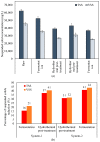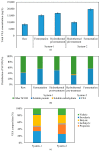Comparison of Two Process Schemes Combining Hydrothermal Treatment and Acidogenic Fermentation of Source-Separated Organics
- PMID: 31013911
- PMCID: PMC6514947
- DOI: 10.3390/molecules24081466
Comparison of Two Process Schemes Combining Hydrothermal Treatment and Acidogenic Fermentation of Source-Separated Organics
Abstract
This study compares the effects of pre- and post-hydrothermal treatment of source- separated organics (SSO) on solubilization of particulate organics and acidogenic fermentation for volatile fatty acids (VFAs) production. The overall COD solubilization and solids removal efficiencies from both schemes were comparable. However, the pre-hydrolysis of SSO followed by acidogenic fermentation resulted in a relatively higher VFA yield of 433 mg/g VSS, which was 18% higher than that of a process scheme with a post-hydrolysis of dewatered solids from the fermentation process. Regarding the composition of VFA, the dominance of acetate and butyrate was comparable in both process schemes, while propionate concentration considerably increased in the process with pre-hydrolysis of SSO. The microbial community results showed that the relative abundance of Firmicutes increased substantially in the fermentation of pretreated SSO, indicating that there might be different metabolic pathways for production of VFAs in fermentation process operated with pre-treated SSO. The possible reason might be that the abundance of soluble organic matters due to pre-hydrolysis might stimulate the growth of more kinetically efficient fermentative bacteria as indicated by the increase in Firmicutes percentage.
Keywords: acidogenic fermentation; hydrothermal treatment; microbial community analysis; particulate organics solubilization; source separated organics; volatile fatty acids.
Conflict of interest statement
The authors declare no conflict of interest. The funders had no role in the design of the study; in the collection, analyses, or interpretation of data; in the writing of the manuscript, or in the decision to publish the results.
Figures






Similar articles
-
Effect of enzymatic pretreatment on solubilization and volatile fatty acid production in fermentation of food waste.Water Sci Technol. 2005;52(10-11):51-9. Water Sci Technol. 2005. PMID: 16459776
-
Improving production of volatile fatty acids from food waste fermentation by hydrothermal pretreatment.Bioresour Technol. 2014 Nov;171:323-9. doi: 10.1016/j.biortech.2014.08.062. Epub 2014 Aug 28. Bioresour Technol. 2014. PMID: 25218204
-
Novel insight into the relationship between organic substrate composition and volatile fatty acids distribution in acidogenic co-fermentation.Biotechnol Biofuels. 2017 May 26;10:137. doi: 10.1186/s13068-017-0821-1. eCollection 2017. Biotechnol Biofuels. 2017. PMID: 28559928 Free PMC article.
-
Upflow anaerobic sludge blanket reactor--a review.Indian J Environ Health. 2001 Apr;43(2):1-82. Indian J Environ Health. 2001. PMID: 12397675 Review.
-
Enhanced volatile fatty acids production from anaerobic fermentation of food waste: A mini-review focusing on acidogenic metabolic pathways.Bioresour Technol. 2018 Jan;248(Pt A):68-78. doi: 10.1016/j.biortech.2017.06.121. Epub 2017 Jun 26. Bioresour Technol. 2018. PMID: 28693950 Review.
References
-
- Luk G.K., Bekmuradov V. Energy products from source-separated organic waste. WIT Trans. Ecol. Environ. 2014;180:469–478.
-
- Hosseini Koupaie E., Azizi A., Bazyar Lakeh A.A., Hafez H., Elbeshbishy E. Comparison of liquid and dewatered digestate as inoculum for anaerobic digestion of organic solid wastes. Waste Manag. 2019;87:228–236. - PubMed
-
- Lee W.S., Chua A.S.M., Yeoh H.K., Ngoh G.C. A review of the production and applications of waste-derived volatile fatty acids. Chem. Eng. J. 2014;235:83–99. doi: 10.1016/j.cej.2013.09.002. - DOI
MeSH terms
Substances
Grants and funding
LinkOut - more resources
Full Text Sources

